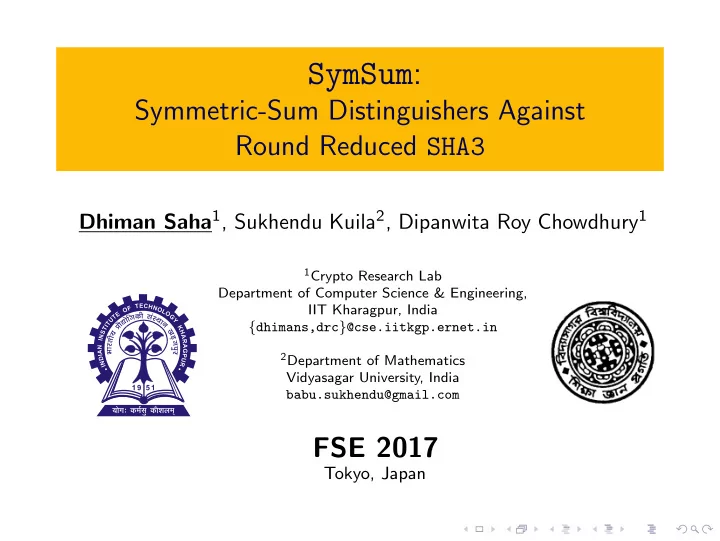

SymSum : Symmetric-Sum Distinguishers Against Round Reduced SHA3 Dhiman Saha 1 , Sukhendu Kuila 2 , Dipanwita Roy Chowdhury 1 1 Crypto Research Lab Department of Computer Science & Engineering, IIT Kharagpur, India { dhimans,drc } @cse.iitkgp.ernet.in 2 Department of Mathematics Vidyasagar University, India babu.sukhendu@gmail.com FSE 2017 Tokyo, Japan
Basics SHA3 / Keccak ◮ Follows SPONGE construction ◮ Internal permutation called Keccak - f / Keccak - p ◮ Internal state ◮ Array of 5 × 5 slices ◮ Biggest size → 1600 bits ◮ Total 24 rounds ◮ 1 Round = 5 sub-operations R = ι ◦ χ ◦ π ◦ ρ ◦ θ Note: Position of ι in the round function Round-constants added at the end of a round
Basics FIPS 202 ◮ SHA3 Family Fixed-Length → SHA3-224/256/384/512 XOF → SHAKE128/256 ◮ Main difference with Keccak Family: ◮ Introduction of the domain separation bits prior to 10*1 padding � M || 01 Fixed-Length Add Suffix M − − − − − − − → M || 1111 XOF
Distinguishing Attacks on Keccak - f Towards exhibiting non-random behaviour
Distinguishers on Keccak - f Target the Hermetic Sponge Strategy Internal permutation of Sponge based hash function should be designed such that they cannot be distinguished from a randomly-chosen permutation. ◮ Maximum results on Keccak- f during SHA-3 competition ◮ e.g., Zero-Sum, Rotational among others Particular Attention Zero-Sum Distinguisher ◮ Based on higher-order derivatives of forward/inverse rounds ◮ Only distinguisher to reach full 24-rounds ◮ Uses inside-out strategy
What about distinguishers on Keccak ? Distinguishing the hash-function itself
Distinguishers on Keccak Distinguishers on Keccak - f may not directly extend to Keccak ◮ Due to restrictions imposed by SPONGE ◮ e.g. Zero-Sum applies ◮ But looses number of penetrable rounds ◮ Inside-out technique invalidated Few results on distinguishers on Keccak hash function ◮ 4-round Keccak ◮ 6-round Keccak ◮ Due to Naya-Plasencia, ◮ Due to Das and Meier R¨ ock, and Meier ◮ Using low weight ◮ Based on biased output differential path bits ◮ Complexity: 2 24 ◮ Complexity: 2 52
An Experiment on SHA3 Based on self-symmetry
Self-Symmetry Internal State ◮ A restriction on the internal σ 2 state of Keccak - f ◮ 1600-bit State ( S ) visualized as two 800-bit Substates σ 1 ( σ 1 , σ 2 ) S = σ 1 || σ 2 ◮ σ i = 5 × 5 × 32 bits The Restriction: Equal Substates σ 1 = σ 2
Self-Symmetric State An Example ◮ A self-symmetric state Table 1: A Self-Symmetric ◮ Represented in standard 62C05E2462C05E24 0934258C0934258C 49DA0D3D49DA0D3D lane × sheet format B6C808B2B6C808B2 24B83B0524B83B05 2026890020268900 ◮ Look at individual lanes 94BA023194BA0231 74F1384174F13841 ADE17841ADE17841 64010A3264010A32 8030F1308030F130 E383F57AE383F57A ◮ The first Substate is 68DD183C68DD183C 36FB572A36FB572A 120A313A120A313A highlighted Table 1: A Self-Symmetric state. σ 1 is highligted. 62C05E2462C05E24 0934258C0934258C 49DA0D3D49DA0D3D 2923A54B2923A54B 8817062C8817062C B6C808B2B6C808B2 24B83B0524B83B05 2026890020268900 738E1141738E1141 3886D76A3886D76A 94BA023194BA0231 74F1384174F13841 ADE17841ADE17841 411E023D411E023D 98C34C6798C34C67 64010A3264010A32 8030F1308030F130 E383F57AE383F57A 35388C8235388C82 61F7231161F72311 68DD183C68DD183C 36FB572A36FB572A 120A313A120A313A 1C6E105D1C6E105D B50D7CA2B50D7CA2
Experiment Message Set (SHA3-512) Pad ( AddSuffix (Message)) → Self-Symmetric Internal State ◮ Single block messages 8cd812d28cd812d2 ◮ Similar to ZeroSum computation ****0*9b****0*9b 0000000000000000 ◮ But with additional restriction of 0000000000000000 preserving symmetry ◮ By construction, � Msg = 0 Msg ∈ MsgSet 4a36ea584a36ea58 8cd812d28cd812d2 88e61fc788e61fc7 f3372eaff3372eaf ea3f0b51ea3f0b51 ce168c02ce168c02 ****0*9b****0*9b b934cb9fb934cb9f 866ac262866ac262 0000000000000000 0000000000000000 0000000000000000 0000000000000000 0000000000000000 0000000000000000 0000000000000000 0000000000000000 0000000000000000 0000000000000000 0000000000000000 0000000000000000 0000000000000000 0000000000000000 0000000000000000 0000000000000000 Zeros at end indicate value of capacity bits
Experiment 4-rounds SHA3 -512 ◮ Run SHA3 (Round-Reduced) over the Message Set ◮ Compute Output-Sum What is the nature of the Output-Sum?
Experimental Results The Output-Sum Table 2: Output-Sum exhibiting self-symmetric property | MsgSet | Remark Output-Sum 000000000000000000000000000000000000000000000000 2 17 Zero-Sum 000000000000000000000000000000000000000000000000 00000000000000000000000000000000 000000000000000000000000000000000000000000000000
Experimental Results The Output-Sum Table 2: Output-Sum exhibiting self-symmetric property | MsgSet | Output-Sum Remark 000000000000000000000000000000000000000000000000 2 17 000000000000000000000000000000000000000000000000 Zero-Sum 00000000000000000000000000000000 000000000000000000000000000000000000000000000000 2 16 Zero-Sum 000000000000000000000000000000000000000000000000 00000000000000000000000000000000 000001000000010000000000000000000000200000002000
Experimental Results The Output-Sum Table 2: Output-Sum exhibiting self-symmetric property | MsgSet | Output-Sum Remark 000000000000000000000000000000000000000000000000 2 17 000000000000000000000000000000000000000000000000 Zero-Sum 00000000000000000000000000000000 000000000000000000000000000000000000000000000000 2 16 Zero-Sum 000000000000000000000000000000000000000000000000 00000000000000000000000000000000 000001000000010000000000000000000000200000002000 2 15 Symmetric-Sum 000000000000000000000000000000000000000000000000 00000000000000000000004000000040 243f4942243f4942528c98d5528c98d57300b0d17300b0d1
Experimental Results The Output-Sum Table 2: Output-Sum exhibiting self-symmetric property | MsgSet | Remark Output-Sum 000000000000000000000000000000000000000000000000 2 17 Zero-Sum 000000000000000000000000000000000000000000000000 00000000000000000000000000000000 000000000000000000000000000000000000000000000000 2 16 Zero-Sum 000000000000000000000000000000000000000000000000 00000000000000000000000000000000 000001000000010000000000000000000000200000002000 2 15 000000000000000000000000000000000000000000000000 Symmetric-Sum 00000000000000000000004000000040 243f4942243f4942528c98d5528c98d57300b0d17300b0d1 2 14 Symmetric-Sum c0585999c0585999147b20a3147b20a3083a3900083a3900 09225588092255886302671c6302671c 81ed3fca81ed3dca15553dac15553dec25858e1125858e11
Experimental Results The Output-Sum Table 2: Output-Sum exhibiting self-symmetric property | MsgSet | Remark Output-Sum 000000000000000000000000000000000000000000000000 2 17 Zero-Sum 000000000000000000000000000000000000000000000000 00000000000000000000000000000000 000000000000000000000000000000000000000000000000 2 16 000000000000000000000000000000000000000000000000 Zero-Sum 00000000000000000000000000000000 000001000000010000000000000000000000200000002000 2 15 Symmetric-Sum 000000000000000000000000000000000000000000000000 00000000000000000000004000000040 243f4942243f4942528c98d5528c98d57300b0d17300b0d1 2 14 c0585999c0585999147b20a3147b20a3083a3900083a3900 Symmetric-Sum 09225588092255886302671c6302671c 81ed3fca81ed3dca15553dac15553dec25858e1125858e11 2 13 Not Symmetric 11c9af8b11c9af8b509927bf5099273f9276901992679019 ca92a3d5ca9223d54ffce7974ffc6797 78f523d01479a153802f16a4c8bbb67116d502ea0495823a
Experimental Results The Output-Sum Table 2: Output-Sum exhibiting self-symmetric property | MsgSet | Remark Output-Sum 000000000000000000000000000000000000000000000000 2 17 Zero-Sum 000000000000000000000000000000000000000000000000 00000000000000000000000000000000 000000000000000000000000000000000000000000000000 2 16 000000000000000000000000000000000000000000000000 Zero-Sum 00000000000000000000000000000000 000001000000010000000000000000000000200000002000 2 15 Symmetric-Sum 000000000000000000000000000000000000000000000000 00000000000000000000004000000040 243f4942243f4942528c98d5528c98d57300b0d17300b0d1 2 14 c0585999c0585999147b20a3147b20a3083a3900083a3900 Symmetric-Sum 09225588092255886302671c6302671c 81ed3fca81ed3dca15553dac15553dec25858e1125858e11 2 13 Not Symmetric 11c9af8b11c9af8b509927bf5099273f9276901992679019 ca92a3d5ca9223d54ffce7974ffc6797 78f523d01479a153802f16a4c8bbb67116d502ea0495823a 2 12 Not Symmetric 71057dfbf18b25f22bba947d0ba094fd1240ee380a42df38 99eaa56698fa64e6a21ac1328138c126
What to make of these results? ◮ Results ◮ Partly intuitive ◮ Partly inexplicable ◮ Definitely worth investigating (Our Motivation) First Question What is the underlying operator in the experiment? Intuition We must be computing some kind of higher order derivative. ◮ But not simple higher order derivatives (as in case of classical Zero-Sum) ◮ Recall: Multiple variables change values per call ◮ Also, the self-symmetry constraint
m − fold vectorial derivatives The Operator So, What is the underlying operator? Answer: m − fold vectorial derivatives 1 ◮ Slightly different notion of higher-order derivatives ◮ Analogous to computing derivatives over a subspace ◮ Partitions the inputs variables The Experiment ≡ Computing m − fold vectorial derivatives with specially selected subspaces Specially selected subspace → Self-Symmetry constraint 1 Refer paper for mathematical form
Recommend
More recommend